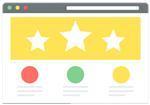Web Design 101
Web Design 101
Adhere to the following basic guidelines, and you are already on your way to making an effective website.
Functionality vs. Visual Appeal

While the attractiveness of a page is important, it is secondary to functionality. Consider what your audience is looking for and make it as easy to find as possible while keeping clutter to a minimum. Entice someone to come to your page, stay on your page, and return to your page by presenting a layout that is:
- Clean
- Uncluttered
- Professional, and
- Simple
Aim to underwhelm, not overwhelm. White space and minimal text is good. Dark backgrounds, lots of text, and too many bells and whistles cause the user's stress level to go up and leave as quickly as possible. If you remember anything, remember these three words: keep it simple.
Consider Your Message
 Think about why someone is coming to your page. It's probably not because they are curious about your mission and vision (although some may be, and that is good information to feature on an About Us page). Ask yourself what your audience is looking for and make that information available right up front on your landing page. Keep lower priority information on a separate page.
Think about why someone is coming to your page. It's probably not because they are curious about your mission and vision (although some may be, and that is good information to feature on an About Us page). Ask yourself what your audience is looking for and make that information available right up front on your landing page. Keep lower priority information on a separate page.It's generally a good idea to include the following as essentials for every section:
- A landing or Home page with the most high priority information available right up front.
- An About Us page indicating why you exist and what you do.
- A Contact Us page with easy information on how to get in touch with you if users have questions.
Keep your content fresh and current. If information is out-of-date or not relevant to what people are seeking, remove it. Remember more "stuff" does not make for a better website. In fact, too much clutter tends to overwhelm and frustrate the user. Monitor your traffic patterns and be responsive to what users are saying they have a hard time finding. Redesign your site on a regular basis accordingly. Remember: a website is never finished. It continues to evolve as the organization grows and changes.
Tip: Avoid "Happy Talk" and Redundant Language - It's always tempting to post messages welcoming visitors to your site or lines explaining that there is a menu on the left, please go to it, etc. As a general rule, avoid placing any text on your page that isn't critical. Consider whether your users can find what they need without the text. If the answer is yes, then leave it out. If the answer is no, the site could probably use a more intuitive layout. Our Web Services team can help analyze your page and make recommendations on how to improve navigability.
Ease of Navigation
 Digging for information frustrates users and discourages them from coming back. Follow these basics, and you should have a very navigable site:
Digging for information frustrates users and discourages them from coming back. Follow these basics, and you should have a very navigable site:- Your main navigation bar should run down the left side of your page. There are two reason for this: 1) we are accustomed to reading from left-to-right and top-to-bottom, and 2) users are accustomed to looking to the left when determining where to navigate. This along with the rest of your page layout should stay consistent across all your pages. It helps the user know where to look when navigating from page to page.
- Rule of 5 for menus: Your top menu should have a maximum of five choices. If you are offering more than that, you should consolidate items into submenus. Longer menus make it harder to find things.
- Rule of 3 clicks: If it is taking more than three clicks from your landing page to the information someone is looking for, then the information is buried too deep. Either relocate more up front or consider whether it is needed at all.
The above guidelines may almost seem at odds with one another, but if you strike the right balance between these two, you can be sure your site is easy to navigate.
Visuals and Colors
 Images help your site's attractiveness but can also add clutter if not used wisely. Use colors that are well balanced and "friendly" (more below) and try to maximize smiling people and round shapes. These make people feel happy and welcome.
Images help your site's attractiveness but can also add clutter if not used wisely. Use colors that are well balanced and "friendly" (more below) and try to maximize smiling people and round shapes. These make people feel happy and welcome.
Any graphic which has a directional aspect should be placed to point the eye towards the most important section of the page. If you have a picture of a bird on the top left corner of your page, make sure it is facing inward and that its beak is leading the eye to the centre of the page, not away from it.
- Colors matter. They affect our emotions. Remember these basics:
- Red and orange excite the senses and increase heart beat
- Blues and greens are more restful
- Yellow reminds us of sunshine and is a happy








